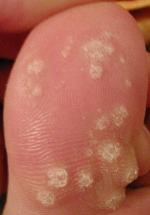Wart

| Wart | |
|---|---|
| Other names | Verrucae,[1] papillomas[2] |
| Medical specialty | Dermatology |
| Symptoms | skin growth usually occurring on the hands, feet, or genitals[1][3] |
| Duration | Months to years[1] |
| Causes | Human papillomavirus[1] |
| Risk factors | Public showers and pools, eczema[3] |
| Differential diagnosis | Callus, seborrheic keratosis, squamous cell carcinoma[4] |
| Prevention | Avoiding skin contact with infected individual, not walking barefoot in public areas, having safe sex or sexual abstinence |
| Treatment | Salicylic acid, cryotherapy,[1] surgical removal |
| Frequency | Very common[2] |
Warts are growths on the skin. Very often they resemble solid blisters.
Usually, applying pressure to a wart causes pain. Warts are caused by viruses in the HPV family. As there are many types of viruses in the HPV family, there are also many types of wart. In most cases, warts are not dangerous, but may cause a lot of pain.


The virus infects skin cells. If these infected skin cells move to other areas, new warts can grow there. With some warts, infected skin that has touched surfaces that other people touch can spread warts, so it may be better to wear socks or crocs. Warts contain tissue that bleeds easily. A bleeding of this tissue allows the wart to spread to other places. In general, coming in contact with infected tissue spreads the infection.
There are different ways of getting rid of a wart:
- The immune system fights the virus, and can make the wart disappear.
- There are different drugs; many of them are corrosive acids. Regular application on the skin kills the cells which were infected by the virus. Other drugs strengthen the immune system.
- Some of the acids are difficult to handle, or have side-effects. Often, trained medical personnel is needed for their use.
- Different forms of surgery exist: Using a laser, electricity, or infrared radiation. Very often, the use of surgery causes scars.
Types of warts
[change | change source]There are different types of warts, caused by different HPV viruses:
- common wart: a wart standing out, with a rough surface, usually occurs on hands or knees.
- flat wart: A small smooth flattened wart, which can occur in large numbers. Most common on the face, neck, hands, wrists and knees;
- filiform or digitate wart: These warts look like threads or fingers. Most common on the face, especially near the eyelids and lips;
- plantar wart: A hard sometimes painful lump, often with many black dots in the center; usually only found on pressure points on the soles of the feet and on hands;
- mosaic wart: Many plantar warts close together. Usually on the hands or soles of the feet
- genital wart A wart that occurs on the genitals.
Treatment
[change | change source]There are multiple different ways of getting rid of a wart:
- Some over the counter drugs, which usually contain an acid, very often salicylic acid. Getting rid of a wart that way involves cleaning the area around the wart, and treating it with the acid. This will slowly kill wart tissue. Dead tissue can then be removed. Getting rid of a wart this way usually takes several weeks. There are different drugs, with different acids. Some prescription drugs may contain stronger acids, such as chloroacetic acid or silver nitrate. All acids are caustic. This means, healthy tissue around the wart needs to be protected, before the substance is applied.
- It is possible to kill off the wart using extreme cold (called cryotherapy). A physician or a specialist doctor for skin diseases usially does this. Before the cold is applied, a local anestetic is used to reduce the pain. Using this method will cause scars.
- It is possible to do a special chemotherapy, called cytostatis. This will prevent cell growth.
- It is possible to boost the immune system so it can better fight the wart.
Related pages
[change | change source]References
[change | change source]- ↑ 1.0 1.1 1.2 1.3 1.4 Cite error: The named reference
Loo2014was used but no text was provided for refs named (see the help page). - ↑ 2.0 2.1 Cite error: The named reference
PubMed2016was used but no text was provided for refs named (see the help page). - ↑ 3.0 3.1 Cite error: The named reference
IQ2014was used but no text was provided for refs named (see the help page). - ↑ Cite error: The named reference
Bo2012was used but no text was provided for refs named (see the help page).